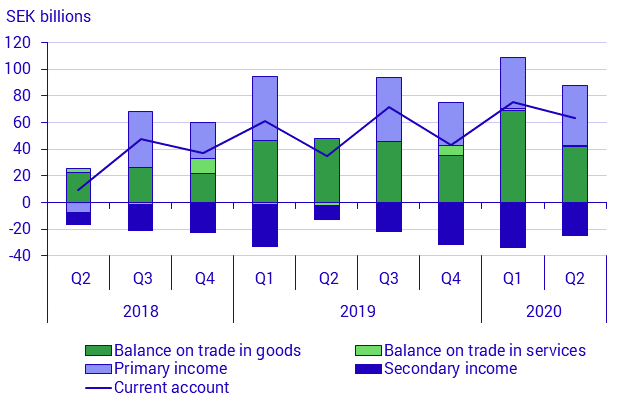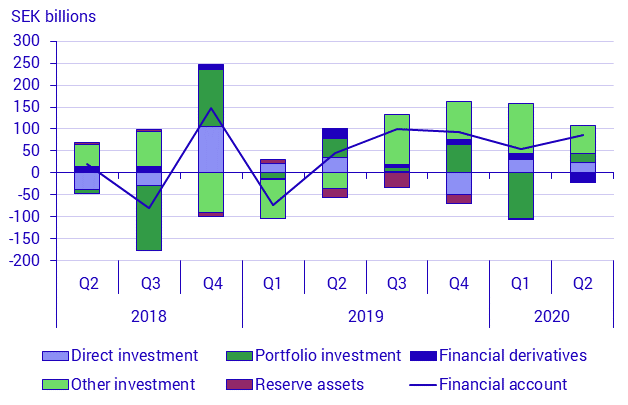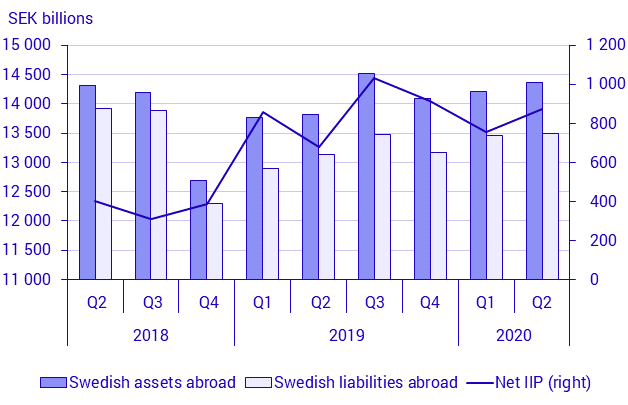Balance of payments, 2nd quarter 2020
Investment income contributed to a strengthened current account
Statistical news from Statistics Sweden 2020-09-07 9.30
The current account surplus widened to SEK 63.2 billion in the second quarter of 2020, which was SEK 28.5 billion more than in the second quarter of 2019. Exports and imports of goods and services decreased sharply, while the balance was relatively unaffected. Investment income was the contributing factor to the widened current account surplus, as many Swedish companies refrained from paying dividends in the second quarter of 2020.
The financial account shows that net lending with the rest of the world amounted to SEK 86.6 billion in the second quarter. Sweden’s net external assets position, presented in the international investment position, amounted to SEK 873.4 billion at the end of the second quarter of 2020.
What is the Balance of Payments?
The balance of payments is a statement of all Swedish transactions with the rest of the world. It presents exports and imports of goods and services, and includes a description of changes in financial assets and liabilities with the rest of the world. The balance of payments consists of the current account, the financial account, and the capital account. The component parts of the Balance of Payments and related terms are explained under Definitions and explanations, at the end of this item of statistical news.
Current account surplus as share of Sweden’s GDP increased
Sweden’s current account as a percentage of GDP has widened in recent quarters, and amounted to 5.1 percent in the second quarter of 2020, calculated as an average over the last four quarters. The current account as a percentage of GDP last reached this level in the fourth quarter of 2013.

Comparisons between periods in the current account are made using the corresponding quarter the previous year.
Balance on trade in goods presented a narrowed surplus
The balance on trade in goods resulted in a surplus of SEK 42.3 billion, narrowed by SEK 5.5 billion from the second quarter of 2019. Compared with the corresponding quarter a year ago, exports and imports of goods decreased sharply. Goods exports amounted to SEK 353.1 billion, down by SEK 71.9 billion compared with the corresponding quarter a year ago. Goods imports amounted to SEK 310.9 billion, down by SEK 66.3 billion in a corresponding comparison.
Surplus in merchanting, which is included in the balance on trade in goods, amounted to SEK 22.8 billion, down by SEK 8.3 billion from the second quarter of 2019.
Imports and exports of services decreased
The balance on trade in services noted a surplus of SEK 0.7 billion, compared with the deficit of SEK 2.2 billion in the second quarter of 2019. Export of services amounted to SEK 145.1 billion, down by SEK 29.3 billion compared with the corresponding quarter a year ago. At the same time, import of services amounted to SEK 144.4 billion, down by SEK 32.2 billion in a corresponding comparison. Although exports and imports were affected by the coronavirus pandemic in the first quarter of 2020, they were even more affected in the second quarter, and both exports and imports decreased sharply.
Increase in investment income led to a surplus in primary income
Primary income, which consists mainly of compensation of employees and investment income, noted a surplus of SEK 44.9 billion in the second quarter. This can be compared with a deficit of SEK 1.1 billion in the corresponding quarter a year ago. The main contributing factor to the primary income surplus was investment income, which went from a deficit of SEK 4.5 billion in the second quarter of 2019 to a surplus of SEK 40.3 billion in the second quarter of 2020.
Income on portfolio investment, which generated the surplus in investment income, noted a surplus of SEK 26.0 billion in the second quarter of 2020, compared with a deficit of SEK 26.5 billion in the second quarter of 2019. Investment income from portfolio investment usually follows a seasonal pattern and the net balance is generally lower in the second quarter, when many Swedish companies pay dividends. However, in the second quarter of 2020, many Swedish companies refrained from paying dividends, which strengthened the current account.
Income on direct investment contributed a surplus of SEK 15.7 billion, down by SEK 5.2 billion compared with the second quarter of 2019.
Secondary income deficit widened
Secondary income, which includes current international cooperation and contributions to and from the EU, presented a deficit of SEK 24.7 billion. This deficit increased by SEK 15.0 billion compared with the corresponding quarter a year ago.
Net lending in the financial account
The financial account noted net lending amounting to SEK 86.6 billion in the second quarter of 2020. Net lending and net borrowing refer to the overall balance on the financial account.
Other investment, direct investment and portfolio investment in the financial account present net lending during the quarter. At the same time, financial derivatives present net borrowing and reserve assets present decreased net lending during the quarter.

Foreign direct investment in Sweden decreased
Net lending in direct investment amounted to SEK 23.7 billion during the quarter. Foreign direct investment in Sweden decreased by SEK 12.5 billion, while Swedish direct investment abroad increased by SEK 11.2 billion.
Portfolio investment increased abroad and in Sweden
Net lending in portfolio investment amounted to SEK 21.1 billion during the quarter. Swedish investors increased their portfolio investment abroad by SEK 50.7 billion, while foreign investors increased their portfolio investment in Sweden by SEK 29.6 billion.
Other investment decreased in Sweden and abroad
Net lending in other investment corresponded to SEK 63.3 billion. Foreign other investment in Sweden decreased by SEK 154.7 billion, while Swedish other investment abroad decreased by SEK 91.4 billion.
Financial derivatives and reserve assets
Net borrowing in financial derivatives amounted to SEK 20.7 billion. Reserve assets noted decreased net lending corresponding to SEK 0.7 billion.
Net assets in Sweden’s international investment position increased
Sweden’s net external assets position amounted to SEK 873.4 billion, which means a widening compared with the previous quarter, when net assets amounted to SEK 755.2 billion. Portfolio investment contributed most to the increase of net assets, through decreased net liabilities. After sharp stock market declines in the first quarter, the second quarter was characterised by recovery and the value of equity shares in portfolio investments has increased.

Comparisons between periods in the international investment position are made using the previous quarter.
Swedish external liabilities increased
Swedish external liabilities amounted to SEK 13 486.8 billion, which is SEK 33.1 billion more than in the last quarter. The second quarter was marked by recovery on the stock market and an increase in the value of foreign holdings of Swedish equity and investment fund shares, while Sweden’s external liabilities in other investments decreased.
Swedish external assets increased
Swedish external assets amounted to SEK 14 360.2 billion, which is SEK 151.3 billion more than in the last quarter. The quarter was characterised by the recovery on the stock market, which affected the value of equity shares, and equity and investment fund shares in portfolio investment contributed most to this increase. This was offset by a decrease in direct investment and other investment.
Sweden’s largest net external assets are in other investment
Other investment, direct investment and reserve assets account for the largest net external assets. The largest net liabilities are in long-term debt securities in portfolio investment.
Revisions
The time series for the Balance of Payments and the international investment position has been revised from Quarter 1 2018.
The Balance of Payments adheres to a predetermined revision policy, see Section 2.3 in the 2020 Quality Declaration.
In a compilation of the balance of payments and the international investment position, data based on forecasts is used in some cases. The statistics will be updated as results are received. If new data is added or any methodological changes are made, further revisions are carried out as necessary.
Revisions carried out in connection with the publication of the second quarter 2020 are listed in the tables on revisions by account item in the balance of payments and the international investment position, respectively.
Definitions and explanations
The current account and the financial account record real and financial transactions with regard to the rest of the world. Only transactions are recorded; value changes, such as exchange rate fluctuations are excluded.
The current account shows the trade in goods (foreign trade in goods), the trade in services (foreign trade in services), primary income (compensation to employees, investment income, other primary income), and secondary income (current transfers). Surplus and deficit in the current account refer to the difference between Sweden’s exports and Sweden’s imports. A positive outcome results in a surplus, while a negative outcome results in a deficit. Comparisons between periods in the current account are always made using the corresponding quarter the previous year, due to seasonal patterns in data.
The financial account consists of direct investment, portfolio investment, financial derivatives, other investment, and reserve assets. Sweden can acquire and dispose of financial assets abroad. All transactions during the quarter concerning external assets show Sweden’s change in net external assets. Sweden can also borrow and repay financial external liabilities. All transactions during the quarter concerning external liabilities show Sweden’s change in net external liabilities. The difference between Sweden’s change in net external assets and Sweden’s change in net external liabilities can be positive or negative, and shows net lending and net borrowing, respectively.
The capital account records Sweden’s capital transfers and transfers of non-financial assets with regard to the rest of the world. Compared with other parts of the balance of payments, amounts in the capital account are usually small.
The difference between Sweden’s financial external assets and liabilities position is the net of Sweden’s international investment position, which can be positive or negative.
An increase or decrease in assets describes Sweden’s external assets. An increase or decrease in liabilities describes Sweden’s external liabilities.
Merchanting, which forms a part of the trade in goods, refers to triangular trade in which goods are purchased and sold abroad without the good crossing a Swedish border.
Statistical Database
More information is available in the Statistical Database
Feel free to use the facts from this statistical news but remember to state Source: Statistics Sweden.
